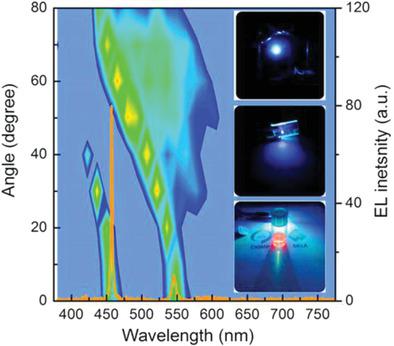当前位置:
X-MOL 学术
›
Adv. Opt. Mater.
›
论文详情
Our official English website, www.x-mol.net, welcomes your
feedback! (Note: you will need to create a separate account there.)
Microcavity‐Enhanced Blue Organic Light‐Emitting Diode for High‐Quality Monochromatic Light Source with Nonquarterwave Structural Design
Advanced Optical Materials ( IF 8.0 ) Pub Date : 2020-01-17 , DOI: 10.1002/adom.201901421 Jie Lin 1 , Yongsheng Hu 1 , Xingyuan Liu 1, 2
Advanced Optical Materials ( IF 8.0 ) Pub Date : 2020-01-17 , DOI: 10.1002/adom.201901421 Jie Lin 1 , Yongsheng Hu 1 , Xingyuan Liu 1, 2
Affiliation

|
Despite their rapid development, organic light‐emitting diodes (OLEDs) are limited to display and lighting applications, and exploiting the application and development of OLEDs has become one of the critical issues. In this study, a new type of distributed Bragg reflector (DBR) with low absorption spacer as a bottom mirror is developed through nonquarterwave structural design. Different factors affecting the electroluminescence (EL) properties of microcavity OLEDs (MOLEDs) are investigated by using the optical microcavities with different structures to regulate the EL properties of 4,4′‐bis[(N‐carbazole)styryl] biphenyl (BSB‐Cz). The optimized MOLEDs with quarterwave DBRs exhibited a maximum external quantum efficiency of 8.86 ± 0.06%, demonstrating an enhancement of 79% compared to a reference device. Under the premise of almost not changing the electrical injection of the functional layer materials in the cavity, the spectral full‐width at half maximum of MOLEDs with a nonquarterwave structural design is as narrow as 2 ± 0.05 nm. These improvements are not only suitable for small organic molecules or polymeric materials, but also for novel nanoluminescent materials, such as quantum dots, perovskites, etc. Overall, the current study suggests the general applicability of this novel concept to obtain high‐quality monochromatic light, irrespective of the type of materials used.
中文翻译:

具有非四分之一波长结构设计的微腔增强型蓝色有机发光二极管,用于高质量单色光源
尽管有机发光二极管(OLED)迅速发展,但仅限于显示和照明应用,而利用OLED的应用和开发已成为关键问题之一。在这项研究中,通过非四分之一波长结构设计开发了一种新型的低吸收间隔物作为底部反射镜的分布式布拉格反射器(DBR)。通过使用具有不同结构的光学微腔来调节4,4'-双[(N-咔唑)苯乙烯基]联苯(BSB-Cz)的EL特性,研究了影响微腔OLED(MOLED)的电致发光(EL)特性的不同因素。 )。具有四分之一波长DBR的优化MOLED的最大外部量子效率为8.86±0.06%,与参考器件相比,提高了79%。在几乎不改变腔中功能层材料的电注入的前提下,采用非四分之一波长结构设计的MOLED的光谱半峰全宽窄至2±0.05 nm。这些改进不仅适用于小的有机分子或高分子材料,而且适用于新型的纳米发光材料,例如量子点,钙钛矿等。总的来说,当前的研究表明,这种新颖的概念对于获得高质量的单色光具有普遍的适用性。 ,无论使用哪种材料。
更新日期:2020-04-06
中文翻译:

具有非四分之一波长结构设计的微腔增强型蓝色有机发光二极管,用于高质量单色光源
尽管有机发光二极管(OLED)迅速发展,但仅限于显示和照明应用,而利用OLED的应用和开发已成为关键问题之一。在这项研究中,通过非四分之一波长结构设计开发了一种新型的低吸收间隔物作为底部反射镜的分布式布拉格反射器(DBR)。通过使用具有不同结构的光学微腔来调节4,4'-双[(N-咔唑)苯乙烯基]联苯(BSB-Cz)的EL特性,研究了影响微腔OLED(MOLED)的电致发光(EL)特性的不同因素。 )。具有四分之一波长DBR的优化MOLED的最大外部量子效率为8.86±0.06%,与参考器件相比,提高了79%。在几乎不改变腔中功能层材料的电注入的前提下,采用非四分之一波长结构设计的MOLED的光谱半峰全宽窄至2±0.05 nm。这些改进不仅适用于小的有机分子或高分子材料,而且适用于新型的纳米发光材料,例如量子点,钙钛矿等。总的来说,当前的研究表明,这种新颖的概念对于获得高质量的单色光具有普遍的适用性。 ,无论使用哪种材料。











































 京公网安备 11010802027423号
京公网安备 11010802027423号